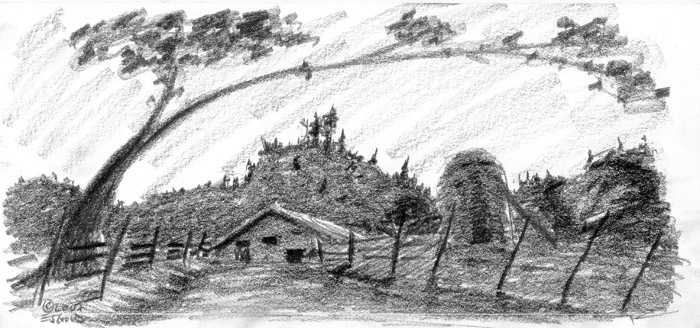
Farm at Land’s End, Pennsylvania is an exercise in light and dark, as well as the translation of “still-life” techniques into Plein-Aire style, with the emphasis on shape, form, mass and composition. Patchy sunlight, silhouetted tree-line, rolling soil and rounded silo with ladders and side-detail, highlighted thatched roofing on the house, soft late-afternoon back-lighting and shadows along the fence-line and banked ditch along the roadside make this a very ambitious drawing project.
GRAPHITE LITHOGRAPHIC STYLE MINIATURE LANDSCAPES — $25 each. Yes, that is the wholesale price, no discount for quantity, because there’s a lot of cost behind each print, and we don’t control the printing costs, the printers do. The originals were created in graphite on Heavyweight 300 gram Arches Rives BFK etching paper, and were massaged into prints by Marvette, who matched the prints with the originals. In a frame, you can’t tell the difference between the print and the original. My original graphite works are no longer for sale, prints only.
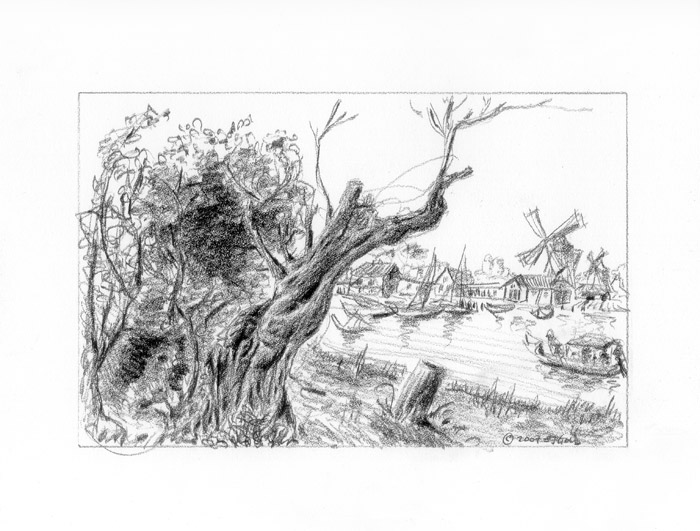
The old, gnarly “Omval” tree was inspired by Rembrandt’s etching, “Omval”. Note the detail on the tree and the over-climbing equally gnarly greenery surrounding it and overtaking it season by season. The Canal is filled with boats of various kinds, and you can see fishing piers and fisherman’s houses, windmills and in the distance, some foliage. A drawing of this kind can take up to a week to complete with all the subtle shades from light and almost invisible to rich, velvety dark.
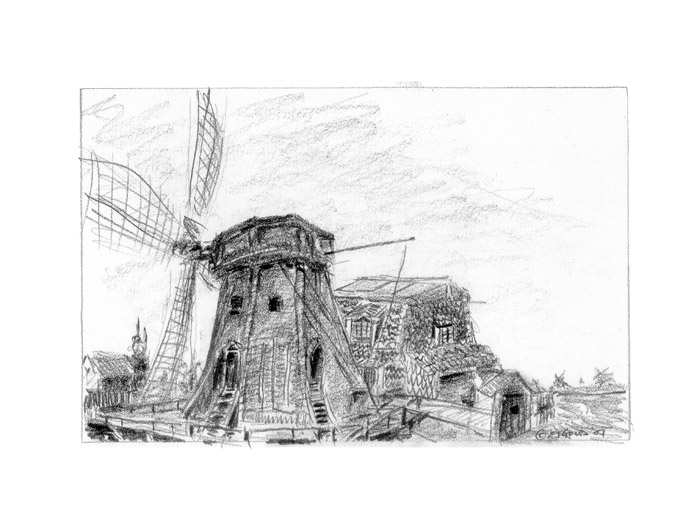
Note the six-sided shape of this hand-built windmill on the canals near Amsterdam. There were no building codes, so you built it however you could and to whatever plan you might happen to have. Blueprints? What are blueprints? Homes were more or less piled together — you did all the work yourself, just as you made your own homespun cloth, butter and shoes or sandals. Everything was homemade, and you swapped or traded the things you made for the things you needed. A Miller specialized in grinding grain, and took animals, food and other provisions in trade for the service, as well as Guilders — cold cash.
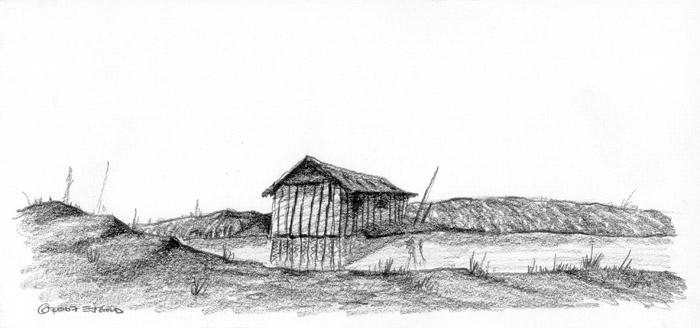
This little cabin and pond with sparse vegetation and cloudless sky is a very ambitious drawing project. Try it, and see why. It’s hard to capture the feeling and sense of “finish” without the wealth of detail you might think you need. Just enough graphic to convey the sense of the scene is the basic drawing problem. It’s a LOT harder than it looks.
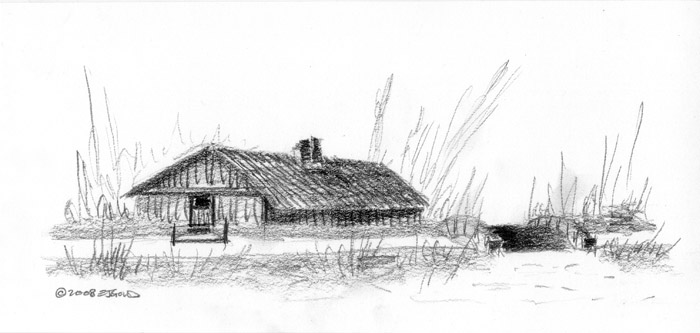
The curved bridge over the small running creek is offset at an angle from the house, to accomodate the curve of the stream at that juncture, with a small fishing dock — clearly not a boat dock because the stream is too narrow for boating, and the low bridge would not accommodate a boat’s passage underneath. It was in fact a fishing dock for the kids, who sometimes caught a sunfish or two.
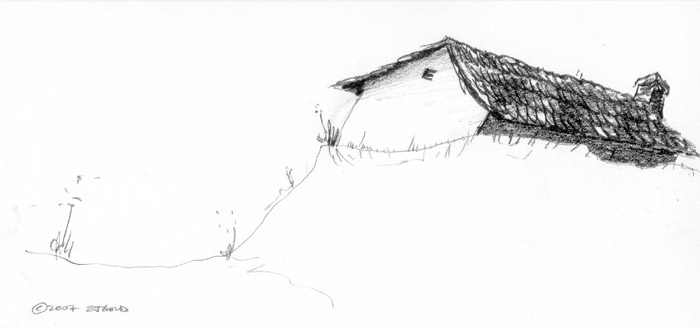
This might look absurdly easy. It’s absurdly SIMPLE, but hardly easy. Try to draw it and you’ll see the many things that can go wrong. Deceptively simple drawing can reveal skills or lack of them.
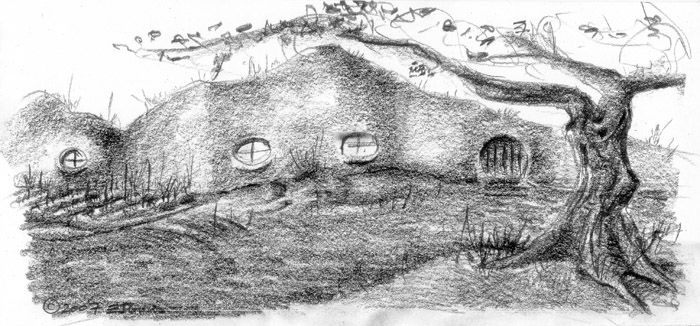
This Shire Home, just below Bag End, was the home of Sam’s Dad, the Gaffer. As you know, Sam & Rosie moved into Bag End when Frodo and Bilbo went West from the Grey Havens. Note the rows of vegetables and the Mushroom Room at the left rear of the house. The gnarly tree adds some character to the composition and the curvy walls present a problem in shadow that any art student should and would welcome.
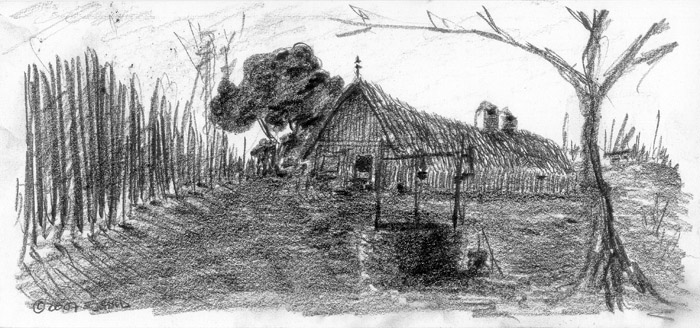
This rural farmland scene is typical of the 17th century, about 1655, and uses elements of light and dark, highlight & shadow, gnarly trees and foliage, distant buildings, cast shadow, back-lighting and a well & bucket for dramatic darks. Note the Dutch door and the detailed workshop and milking shed (for inclement weather) at the left rear of the house. I worked this farm, and remember it well enough to draw it from any angle & viewpoint.
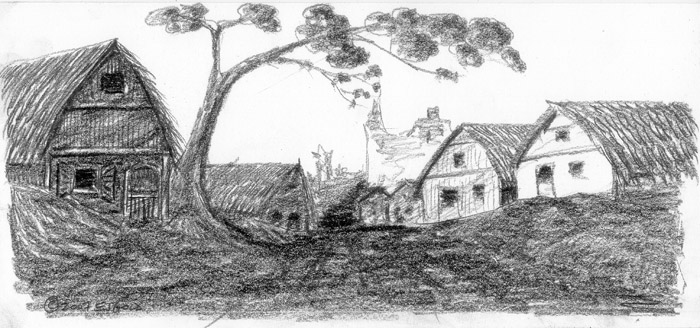
Detail, shadow, highlights and gnarly tree, thatched-roof 17th century houses and shops, along with vague deft-line indications of a distant village just beyond the turn of the remains of the ancient Roman Period cobbled stone road and the lumpy dirt at roadside make this a dramatic scene, around 1651, drawn from my PLS (Past Life Survey) Memory. I’m not really from Mars, but I am from another world. You yourself are probably a Time Traveler, a visitor from the XXth Century, perhaps???
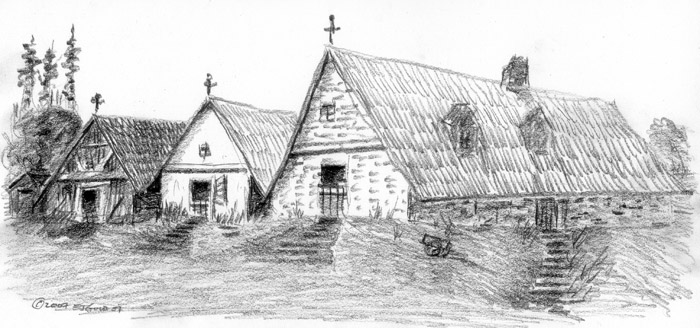
Three Country Houses in a Row in the Lowlands of Holland, about 1656, depicts several owner-built homes of the 16th and 17th centuries, along a banked road near a creek to the South of these buildings, which is to say, to the rear. The frontages are on the South side of the street. Note the treatment of various drawing problems here: stone walls and steps, thatchted roofs, lightning rods (it was the prevailing door-to-door sales item of its day) and chimney, dormer windows, middle placement of a double stone chimney, inset window frames and shutters, crossbeams, tree-line, foliage, and farm equipment just barely indicated, but definitely there — look along the stone wall of the first house.
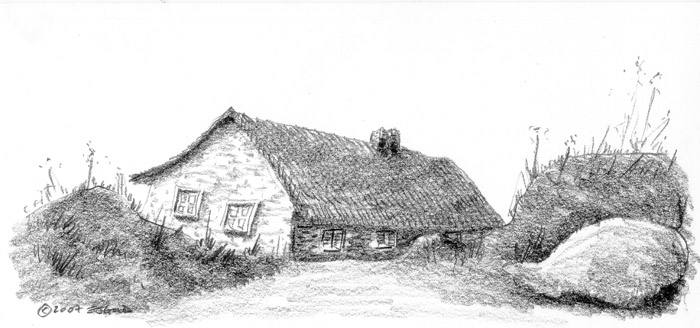
Shire House, South Farthing, ate up a great deal of my drawing time, many hours, in fact, to put in the extreme subtleties of the ground, roof and lumpy hillocks and rocks. It takes time to burnish in the tones, much as it might seem simple and easy. Simple it is, easy it is not, and time-consuming beyond your wildest expectations. If you think net browsing is slow, take a whack at drawing this complex and challenging piece of graphic art. Note the weeds sprouting upward, rolling dented and handcrafted quality of the curved thatch roof, the inset of local stones in the masonry siding of the house, the mass of the big unmoveable stone boulder that defines the curve of the path.
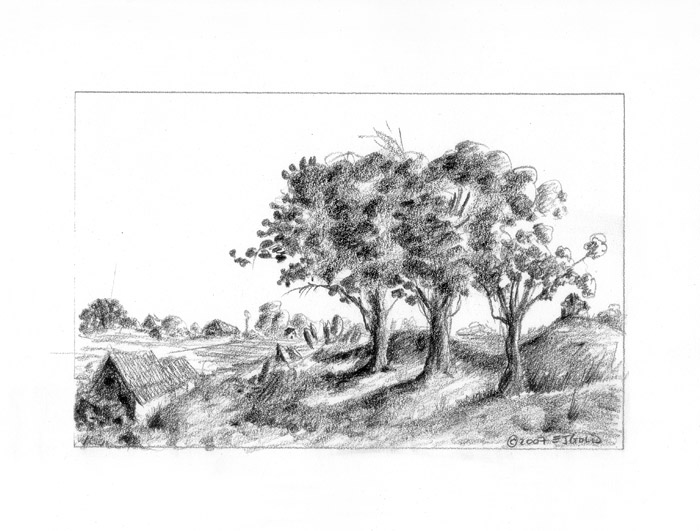
Three Trees is an exercise in composition, light & shadow, highlights, building construction, and extreme detail, but only in choice areas of interest, maintaining a “rolling view” of the scene, where the eye roams over the visual field, picking up various focal points — the house, rock piles, distant hut, house & silo over the far hill, and more. Perspective is the key issue here, along with compositional balance and landscape handling.
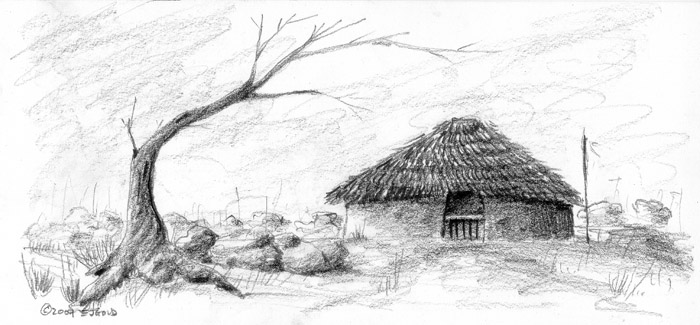
Thatched roof hut at Baguio, Luzon, in the Philippine Islands, South Pacific, was where I lived briefly, at the top of the narrow-gauge railroad that ran up the mountainside to Baguio. Inside the hut resides “Baggy”, a squirrel-monkey who ate me out of house and home, and who could barely play chess — I beat him two out of three games. This sparse sketch demands a lot from the graphic artist, if you keep the free style, don’t cramp it down into “exactitude” or you’ll live to regret it.
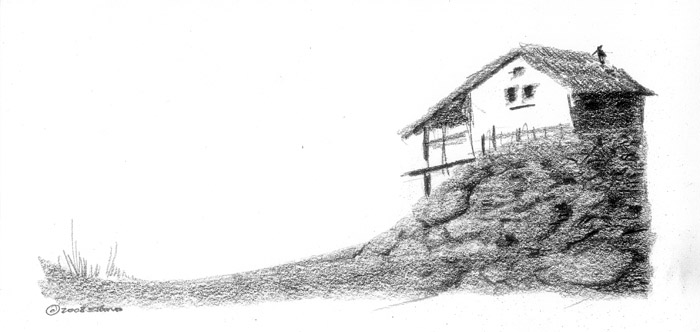
This little beach house at Laguna Beach, California, was the home of one of my art teachers, Rico LeBrun. Note the slag-heap of raw natural stones that support the house, the porch and pilings, the tilt of the house and the barren empty sky and sparse weedy vegetation at the left side of the road, giving the feeling of the desolate nature of the place.
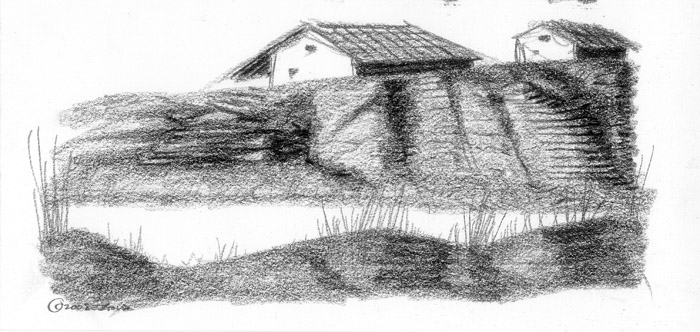
Adobe Houses at Malaga is an example of the use of contrasts between highly graphite-exploited shadow areas and the white of the paper, the natural highlights, to create a number of points of interest in a very small picture area. Note the extreme development of the lateral strips of rocky, sandy soil on the right, and the tumble of roughly-hewn logs toward the left; also please note that at NO time do I EVER use an eraser. Note also the under-eave shadow treatment and slanted lines to give the impression of wooden beams under the clay tile roof.
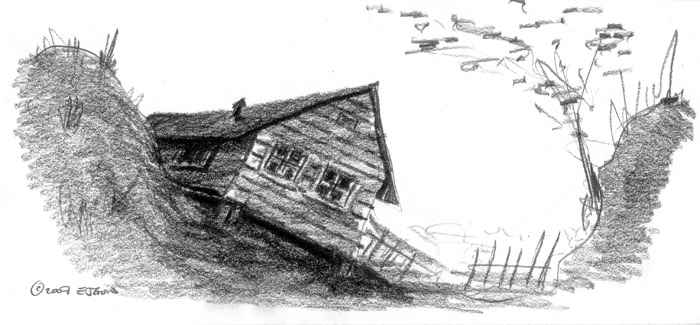
Tilted Cabin shows the dramatic effect of exaggeration and distortion and point of view, angle and tilt, just as you would do with a camera, to attract the eye through curiosity. Of course, if the cabin were really that tilted, it would be uninhabitable, and it isn’t. It’s all in the angle of view. Note the extreme development of the shadow areas under the house, which is what makes this piece work.
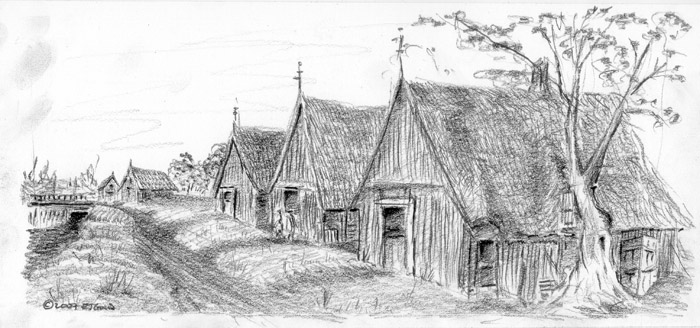
Along the Canals shows my treatment of the 15th-17th century Dutch homes that typically might line a canal, at about 1650-1660. Homes were continually rebuilt, but might have stood for hundreds of years, the original building long since gone, replaced piece-by-piece over the years by generation after generation of owners. Note the Runoff ditch, the low wooden bridge in the distance, thatched roofs and home-built dormer window, mouldings, doors, window-frames and shutters. The waterway is to the far left, over the barrier levee with its canal-fed low vegetation. Every building at this time featured a weather vane and a lightning rod, sometimes combined in one fixture.
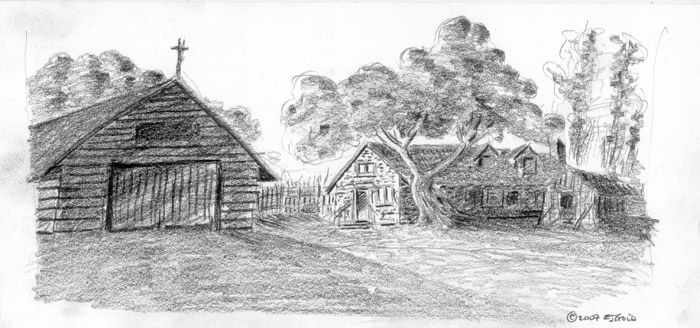
This was a commission from a local art dealer, to produce a lithograph drawing of his home for a greeting card and other applications, plus as an art gift to friends, family and corporate relations. The sheer ordinariness of the scene is a challenge. I used slanted light effects and sharp exploitation of shadows, highlights of white paper left unmarked, stone and wood effects on the house and garden shack, shadow effects under the foliage, and some scribble effects on the trees that tell us that it’s a drawing, not a photo.
That’s the available list at this time. I’ll add more as more become available through the print department, meaning whenever they get scanned and massaged into printable form — it takes about three hours to get one print ready for printing on art paper, and only one in three prints is acceptable as a fine art print, so the cost is higher than you’d expect, to get a print that meets my expectations and artistic demands.
PENCIL-SIGNED AND NUMBERED EDITIONS of these prints are available at $125 each, in an edition of only 50 copies plus four artist’s proofs produced during the course of printing tests — the proofs are never for sale; they are my reference copies.

